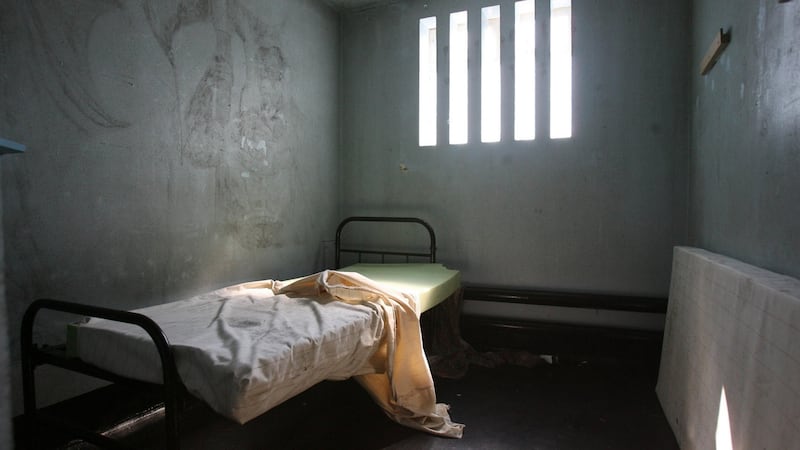On Friday, October 10th, 1980, the republican movement’s H-Block Information Centre published a statement from the blanketmen in H-Blocks 3, 4 and 5 of Long Kesh/Maze Prison. The statement, which announced an impending hunger strike, was hardly a surprise. The protesting prisoners had been discussing the possibility of a hunger strike for well over a year (and British authorities were aware of this). Indeed, the setting up of the National H-Block Committee in late 1979 marked a more pragmatic shift in the thinking of the republican movement and was an attempt to avoid this very situation.
Nevertheless, talks between Cardinal Tomás Ó Fiaich and Secretary of State Humphrey Atkins concerning the on-going situation in the H-Blocks had collapsed in September. The prison protest was now over four years old with little or no end in sight. Prisoners were complaining of an upsurge in brutality at the hands of prison guards (in part, a response to IRA activity “on the outside”.) And, more to the point, republican prisoners were slowly abandoning the protest.
A hunger strike was a high-risk strategy and dramatically upped the ante in the prisoners’ battle against what they saw as the criminalisation of their struggle. Yet from their (mis)reading of history, “political status” – or what the British referred to as Special Category Status – had been won after a hunger strike in 1972. Its announcement was also a much-needed morale boost; a number of “conforming” prisoners returned to the protesting wings of Long Kesh/Maze Prison. There was no shortage of hunger strike volunteers.

For its part, the British government reiterated that it would not be making any concessions to the prisoners, nor would it medically intervene should republican prisoners embark on this form of protest. This left many Northern nationalists – even those who opposed the IRA’s armed campaign – in a very awkward position. Indeed, even organisations such as the European Court of Human Rights had criticised Britain for its “inflexibility” vis-a-vis those protesting in the H-Blocks (though it argued their conditions were largely self-inflicted.) Still, one week before the hunger strike was to commence, the Northern Ireland Office offered what appeared to be a concession: “civilian-type clothing”.
The hunger strike began on Monday, October 27th, 1980. Seven men would initiate the protest. Their number was a nod to the seven signatories to the 1916 Proclamation but they also represented a fairly even geographical spread of the North’s six counties. Brendan Hughes, Raymond McCartney, Tommy McFeely, Leo Green, Tommy McKearney and Sean McKenna represented the IRA; John Nixon represented the INLA.
While the campaign on behalf of the protesting republican prisoners had come to focus on what were referred to as the five demands (the right to wear their own clothes; the right not to do prison work; the right to free association; the right to organise their own educational and recreational activities; and the restoration of full remission), the statement issued by the hunger strikers at the start of their protest returned to the more hard-line language of “political status”. This, they believed, was theirs by right “as captured combatants in the continuing struggle for national liberation and self-determination”.
At about this time, the Northern Ireland Office dramatically increased its spending on public relations. A short, glossy brochure entitled H-Block: the Facts was produced, copies of which were distributed to embassies in the United States, Europe and beyond. The brochure explained the background to the protest, the government’s attitude towards it and highlighted what was on offer to “conforming” prisoners.
In the weeks ahead, anti-H-Block activists organised token fasts, pickets, rallies and public meetings the length and breadth of the country. Thousands would attend marches in Belfast and – more significantly – in Dublin. It had been over a decade since so many people had taken to the streets. Still, the hunger strike continued and in late November it was announced that republican women in Armagh Gaol would be joining the protest.
By mid-December, 30 more republican prisoners joined the hunger strike. Meanwhile, those who initiated the protest had been refusing food for more than seven weeks and their condition was worsening. This was particularly true of McKenna, who would soon be drifting in and out of a coma.
Tremendous pressure now fell on the shoulders of strike leader Brendan Hughes, who had promised his comrade that he would not let him die. With McKenna rapidly approaching death – after 53 days on hunger strike – Hughes made a unilateral decision to end the protest.
For the prisoners and their supporters alike, the ending of the 1980 hunger strike was a period of great confusion and uncertainty. Throughout the protest there had been hints of one sort of agreement or another. In fact, throughout the protest there had been a secret line of communication between the British government and the republican movement. Nevertheless, it wasn’t until after the hunger strike had ended that Hughes and the IRA prison leadership saw any document from the Northern Ireland Office.
The 1980 hunger strike was meant to be a “final step” in the prisoners’ long-fought battle against criminalisation. Given the need to save face and maintain morale, it was suggested that British authorities had made a serious offer to end the hunger strikes and it was now up to anti-H-Block activists to hold them to an agreement. Privately, however, IRA leader Bobby Sands told his comrades: “Fuair muid faic.” (“We got nothing.”)
Dr F Stuart Ross is author of Smashing H-Block: The Popular Campaign against Criminalization and the Irish Hunger Strikes 1976-1982 (Liverpool University Press, 2011)









